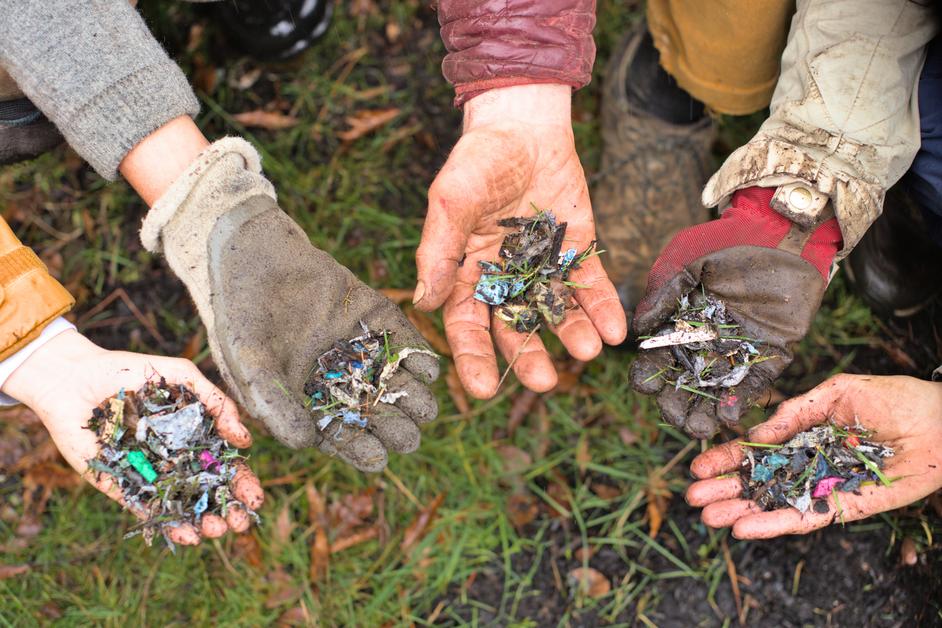Photo by Julian Dahl. Used with permission.
Several of us were out on the land, picking out microplastics from the compost-laden field (see “Plastics in the Soil” on page x). Our friends had put out a call the day before that they needed help, and here we were, on a beautiful almost-spring morning, plastic bags in hand, in section of a two-acre field, looking carefully for tiny bits of plastic in the damp soil in which new grass sprouted.
Some of us had not seen each other in awhile, so, as we plucked, we caught up. Our friends shared about the situation that had led to this, plastics in the sheep field, and some related story. We had morning and afternoon shifts, with lunch provided in between. We’d finish one section, then configure a new section, and so could clearly see our progress. Kids helped as much or as little as worked for them. Dogs were welcome. Sheep nearby (including new lambs) offered a lot of curiosity when we needed breaks.
Conversation deepened, turning to dreams, musings about connection with the land, and how to cultivate and demand the best of oneself (virtues) to meet challenging times. Early February is a time for preparing ones’ tools for the growing season, for sorting seeds and making a garden plan if one hasn’t done so already. Today, we happened to take this time of year to remove plastics from earth – alas, an all too 21st-century environmental task.
That King County and other organizations are failing us in righting a bad situation (microplastics in supposedly organic compost), set us into problem-solving mode. We spoke of making our own compost and of calling on one another for help: Our friend’s email had been a modern version of hollering down the road to neighbors in order to raise a barn together, hold a quilting bee, or receive help with a harvest.
In our times, we may have to deal with toxins, plastics, and other calamities that our ancestors never dreamed of. But at heart, we know – we still know – how to do community. And we can wake up to the strength and promise that nurturing community provides. We begin to know community resilience again.
On this Island, we’re sure you have countless stories to tell about coming together in community to deal with a difficult situation. These are the stories worth vigorously sharing right now. And it’s worth taking note of their common elements, which in turn build community resilience. They are often surprisingly simple.
1. Identify your problem. Typically, it’s something that feels way too much for one person or family to deal with.
2. Reach out to people with whom you’ve shared community. Your friends, neighbors, colleagues. Folks you’ve already engaged with in a reciprocal way, giving and receiving.
3. Let your people know you need help, and specifically how they can help you and when. The more specific you can be, the better. Bonus if you can provide them with food, but if that’s overwhelming, you can also ask folks to bring something to share if they are able to do so.
4. If it feels too hard for you to ask for help or to organize, find just one person to help you do this, or to do it for you.
Truly helpful work, food, fun, and an opportunity to catch up and chat about whatever comes to mind – all of these ingredients, and others like them, bring folks together and nourish community in powerful ways. Being out in nature can really help too, as can making music.
At a certain point in your work, you’ll feel a new sense of what might be possible. This is where the magic happens: when in the course of working together, we come to sense that bigger, deeper landscape. We may glimpse how the Island has called us to be here, and why we might even be called to a specific place upon it. We may come to know ourselves as a people who are so much more than what an agency, organization, or government may these days consider. We begin to discern the strength, imagination, and the driving creative force that we have as a woven community, that these entities lack. We may begin to sense that we have an ability to come together and solve problems in the surprising way that nature has.
For, at the heart of it, we humans are meant to be in community. It’s a natural force. We are not meant to be governed, managed, and told how to think and act – but to surrender to a more expressive, mutually purposeful life that is stronger when we value and respect one another, and know each other as essential, with gifts to share, hands to lend, and the dreams and will to forge new paths.
Organizations and various authorities aren’t going to easily come to a place where they can right the many wrongs, and fix the many problems of our current world, or even just our Island. But look what happens when two or more – in true service and with a curious will – gather to solve a problem or address an issue.
We have so much more than the buckets of microplastics we gathered that day. In restoring the land inch by inch, we grew to care very much about what happens next with it and in a larger sense. We have renewed and strengthened our connections with one another. And we have a new story to tell.
This is Island stuff. It’s a force to be reckoned with.

